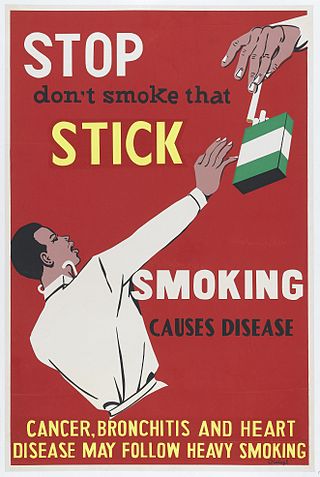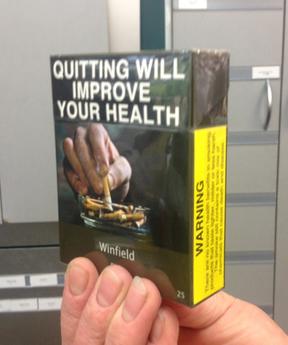Related Research Articles

Smoking bans, or smoke-free laws, are public policies, including criminal laws and occupational safety and health regulations, that prohibit tobacco smoking in certain spaces. The spaces most commonly affected by smoking bans are indoor workplaces and buildings open to the public such as restaurants, bars, office buildings, schools, retail stores, hospitals, libraries, transport facilities, and government buildings, in addition to public transport vehicles such as aircraft, buses, watercraft, and trains. However, laws may also prohibit smoking in outdoor areas such as parks, beaches, pedestrian plazas, college and hospital campuses, and within a certain distance from the entrance to a building, and in some cases, private vehicles and multi-unit residences.

The World Health Organization Framework Convention on Tobacco Control is a treaty adopted by the 56th World Health Assembly held in Geneva, Switzerland on 21 May 2003. It became the first World Health Organization treaty adopted under article 19 of the WHO constitution. The treaty came into force on 27 February 2005. It had been signed by 168 countries and is legally binding in 182 ratifying countries. There are currently 14 United Nations member states that are non-parties to the treaty.
Action on Smoking and Health (ASH) is the name of a number of autonomous pressure groups (charities) in the anglosphere that seek to publicize the risks associated with tobacco smoking and campaign for greater restrictions on use and on cigarette and tobacco sales.

Smoking in Argentina accounts for 15% of total tobacco consumption in the Americas. In the 20th century, the government promoted settlement and economic development in the northern subtropical zones, with tobacco playing a central role. A new government agency worked to educate farmers and promote the cultivation, processing, and marketing of tobacco. While tobacco factories were initially concentrated around Buenos Aires, they gradually extended into the northern production regions. By 1960, Argentina accomplished self-sufficiency in tobacco production. By the 1970s, its annual output exceeded 60,000 metric tons, with one-third exported. At the local level cooperatives are active, they sell to one of two multinational companies, Nobleza-Picardo, an affiliate of the British American Tobacco company, and Messalin-Particulares, associated with Philip Morris International. Argentina held the global rank of third place in terms of production, trailing behind Brazil and Mexico.
The Tobacco Products Control Act was introduced in South Africa in 1993, where smoking has been rated the second highest health concern, after HIV/AIDS.

Tobacco politics refers to the politics surrounding the use and distribution of tobacco, likewise with regulations.

Tobacco control is a field of international public health science, policy and practice dedicated to addressing tobacco use and thereby reducing the morbidity and mortality it causes. Since most cigarettes and cigars and hookahs contain/use tobacco, tobacco control also concerns these. E-cigarettes do not contain tobacco itself, but (often) do contain nicotine. Tobacco control is a priority area for the World Health Organization (WHO), through the Framework Convention on Tobacco Control. References to a tobacco control movement may have either positive or negative connotations, depending upon the commentator.
Smoking in China is prevalent, as the People's Republic of China is the world's largest consumer and producer of tobacco. As of 2022, there are around 300 million Chinese smokers, and 2.4 trillion cigarettes are sold there every year, 46% of the world total.

SmokinginCanada is banned in indoor public spaces, public transit facilities and workplaces, by all territories and provinces, and by the federal government. As of 2010, legislation banning smoking within each of these jurisdictions is mostly consistent, despite the separate development of legislation by each jurisdiction. Notable variations between the jurisdictions include: whether, and in what circumstances ventilated smoking rooms are permitted; whether, and up to what distance away from a building is smoking banned outside of a building; and, whether smoking is banned in private vehicles occupied by children.

Smoking in Nigeria is prohibited in public places. It is punishable by a fine of not less than 50,000 nor exceeding 100,000.00 naira, or by imprisonment to a term of not less than 10 years or your lifetime, or by both a fine and imprisonment.

Smoking in Iceland is banned in restaurants, cafés, bars and night clubs as of June 2007. A large majority of Icelanders approve of the ban. At the time the ban went into effect, almost one in four Icelandic people were smokers.

Plain tobacco packaging, also known as generic, neutral, standardised or homogeneous packaging, is packaging of tobacco products, typically cigarettes, without any branding, including only the brand name in a mandated size, font and place on the pack, in addition to the health warnings and any other legally mandated information such as toxic constituents and tax-paid stamps. The appearance of all tobacco packs is standardised, including the colour of the pack.

Smoking in Albania is prevalent as about 40% of Albanians smoke regularly. In Europe, only Turkey has a higher smoking rate than Albania. Albanians annually spend more than €300 million on tobacco products. Zog I of Albania was reported to smoke 200 cigarettes a day. Albania adopted tough anti-smoking laws in 2007, but they are not strictly enforced. Smoking prevalence is increasing, especially among females ages 13 to 15. The smoking rate for teens between the ages of 13 and 15 is currently 15%.

Smoking in Costa Rica is still somewhat prevalent, and according to the Global Adult Tobacco Survey (GATS) in 2015, 8.9% of the population smoked tobacco. The number of people exposed to secondhand smoke indoors while at the workplace was 6.3% while 4.9% were exposed in their own home.

Tobacco smoking in the Philippines affects a sizable minority of the population. According to the 2015 Global Adult Tobacco Survey (GATS) conducted under the auspices of the Philippines' Department of Health, Philippine Statistics Authority, the World Health Organization, and the United States Centers for Disease Control and Prevention, 23.8 percent of the adult population were "current tobacco smokers". This figures represented 16.6 million of 69 million adult Filipinos.

Tobacco policy in Armenia is the attempt by the Armenian authorities to regulate smoking in Armenia. Tobacco laws and regulations are controlled by the Ministry of Health of Armenia. Armenian men tend to be the most common tobacco users, as 42.5% of men over the age of 15 smoke.
The Smokefree Coalition was established as a national organisation in New Zealand in 1995 to advocate for tobacco control interventions by government and non-government organisations (NGOs). Its founding organisations were the National Heart Foundation of New Zealand, the Cancer Society of New Zealand, Action on Smoking and Health, Te Hotu Manawa Māori and the Asthma and Respiratory Foundation of New Zealand. It ceased operation on 30 June 2016.
Smoking in Latvia is common, with a rate higher than the OECD average, and Latvian men are among the heaviest smokers in the European Union. One in four Latvians smoke, as compared to one in five in the rest of the European Union. While the overall smoking rate in Latvia has decreased in recent years, it is considered a significant factor in the country's significant health challenges, particularly with regard to preventable diseases such as heart disease, diabetes, and cancer.
Switzerland has tobacco legislation defined at federal and cantonal level. It covers protection of the population against passive smoking, restrictions on tobacco advertising, warnings on packaging and taxes.
References
- 1 2 Ockene, J. K. (1996). "Smoking in Ecuador: prevalence, knowledge, and attitudes". Tob Control. 5 (2): 121–6. doi:10.1136/tc.5.2.121. PMC 1759503 . PMID 8910993.
- ↑ "Ecuador, overview of tobacco use, tobacco control legislation, and taxation" (PDF). World Bank Group. 2019-06-17. Archived from the original (PDF) on 2021-09-24.
- 1 2 3 "Tobacco in Ecuador". Euromonitor International. November 2009. Archived from the original on 3 March 2016. Retrieved 6 August 2010.
- ↑ "Ecuador Details - Tobacco Control Laws". tobaccocontrollaws.org.
- 1 2 "WHO | Ecuador – New tobacco control law adopted".
- ↑ Logan, Marty. "The Framework Convention Alliance for Tobacco Control". fctc.org.
